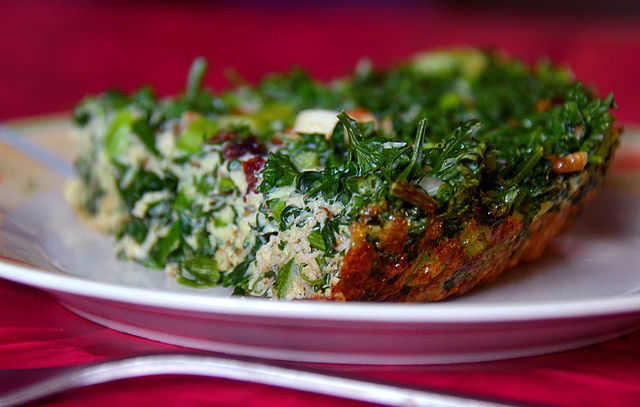Ah, there’s nothing like coming home and finding a hot, fresh pan of kuku sabzi sizzling on the stove. For those unfamiliar with the dish, kuku sabzi is a famous Iranian frittata-like food made with herbs. It looks and tastes much like a prepared spinach cake one might find at the local Whole Foods Market, but is served hot and typically with other foods such as bread, yogurt, or fish. Iranian Jews are very much familiar with kuku sabzi and appreciate its versatility as a vegetarian food that can be eaten with meals containing either dairy or meat.
While Bruins do have the opportunity to try kuku sabzi at one of the many Persian cuisine restaurants in the Los Angeles area, any Iranian in his or her right mind will tell you that the best kuku sabzi is prepared at home with fresh ingredients. For those who would like to take a shot at making the Persian frittata from scratch, here is a recipe provided by my mother, whom I consider to be the master of Persian cuisine.
—
Parve
Yields eight servings
Ingredients:
- 5 eggs
- 2 tablespoons flour
- 1 teaspoon baking powder
- 1 cup fresh parsley
- 1 cup fresh cilantro
- 1 cup chives
- 1 cup dill
- ½ cup crushed walnuts
Wash and dry all of your herbs. Then, chop the herbs into very small fragments. For convenience, you can speed up the process by placing all the herbs into a food processor. Set aside.
In a bowl, mix together the five eggs. Slowly add the baking powder and flour. Be sure to also add some salt, pepper, and turmeric powder to taste. Next, add in your herbs and crushed walnuts. Mix well until everything has been combined.
Heat a non-stick pan over medium heat and lightly grease with oil. Once the pan is hot, pour in the batter. Cover the pan and let the kuku sabzi cook on medium heat for 10 -15 minutes on each side.
Let the kuku sabzi cool for at least 15 minutes (unless you prefer your food steaming hot—then, by all means, go for it). Cut into eight pieces. For epic greatness, serve with mast-o-musir, a Persian yogurt dip made with shallots, and sangak bread. (Both of these items can be found at your local Persian market.)

